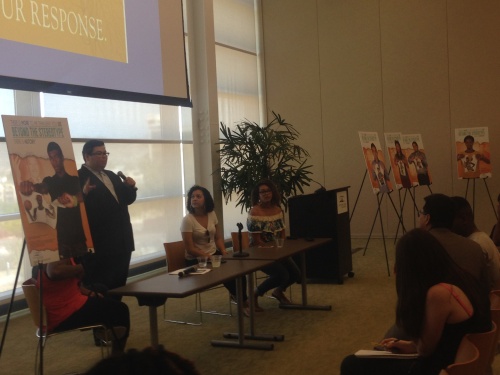By Chelsey Schweitzer
Senior Staff Writer
CSUSM organizations recently hosted a discussion that served to teach students about cultural appropriation and bystander intervention in order to foster an accepting and understanding environment.
This event was held on April 14 as part of the Conversations that Matter Series and was sponsored by the Civility Campaign, the Gender Equity Center, the LGBTQA Pride Center, the Office of Diversity and the CHABSS Engaging Diversity Dialogues. The purpose of this discussion was to further educate students on matters such as stereotypes that can often be seen in society, and how to combat those stereotypes in an educated manner even when the stereotype is directed at somebody else.
The discussion began at 12 p.m. in the USU ballroom and hosted speakers Abrahán Monzón and Greg Toya. The event commenced with Greg Toya, who spoke about the “Beyond the Stereotype” display in the Kellogg Library and the Civility program that is on campus. He introduced the topic of civility, defining it as “conducting oneself with care, respect, empathy, culture and humanity.” This idea was further elaborated upon when he began to talk about the relationship between civility and bystander intervention.
Toya defined bystander intervention as “the willingness to take action and help somebody in need who is in an unwanted situation.” He then described some of the different intervention strategies, such as interrupting rude or unwanted behaviors and encouraging an educational and constructive dialogue about the behavior and why it is unwanted.
Abrahán Monzón facilitated a discussion about triggers, which they defined as “situations of high emotion that catch people off guard.” They went on to describe how these are situations where the emotional nature of the interaction can make it difficult to effectively take control of the situation and intervene through education.
He also spoke of the idea of attempting to see a situation from the other person’s perspective in order to understand what might have led to the unwanted action and thereby more effectively educate the person. The discussion closed with those in attendance sharing some of their personal experiences with bystander intervention and how they had previously dealt with unwanted behavior.
This event encouraged all students to be a part of the bystander intervention discussion, whether they were already familiar with the topic or not.
“I was just walking by [the ballroom], saw the sign and decided to attend; and I’m glad I did,” said Daniesha Thornton, second-year student and Secretary of the Black Student Union.
This event promoted understanding and provided students with tools to use in difficult and possibly emotionally-heated situations. In addition, it encouraged students to take action when they witness an unwanted event and taught them how to be an active bystander under these circumstances.
“We are all human beings, we all bleed the same despite our background and worldviews,” said first year student, Ralph Sibala, after the event. “Every day is a learning experience.”


